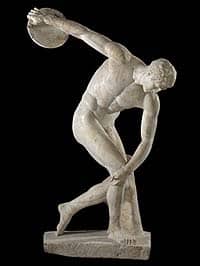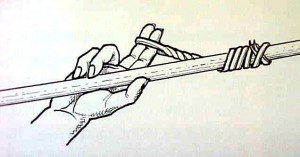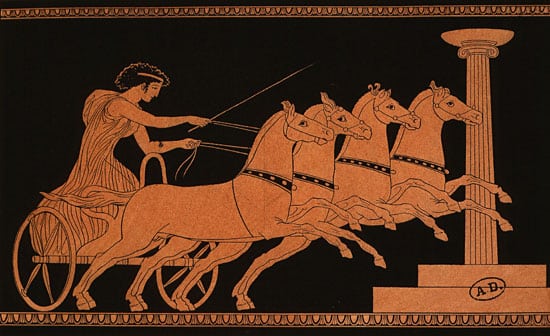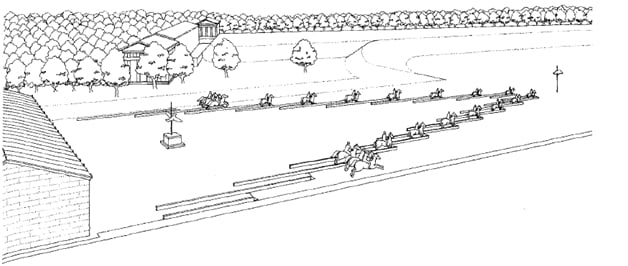- The event consists of 5 prizes
- Stadion/ Wrestling- was apart of both the pentathlon & Olympia

- Discus, Halma (jump) and Akon (javelin throw)
- The competitor must do well in ALL events to have a chance of being crowned a victor
- Not sure if discus were standardized (made of bronze (2kg) or sometimes iron), athletes could have potentially used heavy discus as they progressed into the competition.
- Extremely heavy prize discus was given to a successful pentathlete
- Discus start position: weight on the right leg (rear leg), hold discus at head level in a vertical position; left hand supports the weight of the discus while the right grasps the top edge.
- Not sure if they twisted/ twisted & spun like modern discus throwers (many depictions of twisting & spun motion)
- Diskabolos: (discus thrower) favorite of sculptors
- Semeion: small peg used by discus throwers to mark their throw lengths; also used by jumpers, javelin throwers
- Halteres (weights) were used in the long jump (halma); either spherical or long
- Could be simple and carved by hand, or special pairs could be made for athletes or dedicated winners or gods. (however, nothing was standardized)
- The jump run was made from bater; they jumped into skamma “dig-up” (did not contain sand, which is a modern invention)
- Listening to a flute player was an essential part of the halma
- Jumping, was the most difficult of the rule-based events, and the music was used for rhythm
- The jumpers complete an area in his jump and release the halters at the end of his jump.
- The longest jumps win but footprints must be clear
- Speculated it to be a triple jump, purely based on Phayllos of Kroton (who has a 16.5 meter jump)
- Akon: third and final event of the pentathlon (2m long, diameter if a human thumb) made of wood and bronze tipped; different from the
 spear which consisted of a broad-iron head.
spear which consisted of a broad-iron head. - Ankyle: thin leather thong that was wrapped around the shaft to make a loop for the first two fingers of the throwing hand; this helped to propel the akon (wrapped around the akon, unwrapped [fall completely off] during flight and acting like a rifling effect)
- Took great skill to precisely wrap it and it played a critical part in throwing it; “shaking-down”- the javelin was wrapping using the big toe and used the index/ second finger to throw
- Flute player was also present at the javelin but sources are unsure about their actual purpose
- The throw began with a run-up; javelin was raised to shoulder level, bring the right arm forward and project the javelin, ankyle then flew off.
- A winner was determined by semeion markers [the LONGEST of five throws were marked and counted for each athlete]
- ORDER OF EVENTS: stadion, discus, halma, akon, pale
- DO NOT KNOW exactly how the victor in the pentathlon was determined ( speculation: win 3 of 5 otherwise)
- The competition available to boys were restricted; perhaps to prevent them from peaking too early and performing poorly in the adult games
- Hippikos Agon (Horse Races)- a fundamental component of the ancient games
- Four-horse chariot race (tethrippon) was added to the Olympic games in 680
- Horses were expensive and restricted when and who could compete in horse races

- Consisted of 12 laps around the hippodrome (horse track). May circle around a kampter or nyssa
- NO dividing wall down the center of the track so head-on collisions did occur between racers going toward or away from the kampter
- The chariot was a light vehicle (made of metal or wicker) Wheels had four spokes with a central hole for the axle.
- The Center of the chariot was attached to the two front horses; outside horses were loosely connected
- Charioteer was a slave or professional driver; held long lash with reins (left and right hand); used to control/ steer the horses by pulling/ pushing
- Reins were fastened to broad waistbands to prevent the rider from losing them
- Kiman, legendary chariot rider, won 3 Olympic crowns
- Horses were often named to mythology/ Greek heroes
- The winner of the event was the owner of the horses, not necessarily the driver
- HOWEVER, the city-state entered as competitors, not individuals
- WOMEN were also allowed to win the equestrian at Olympia (Kyniska of Sparta was the first winner; even though they can’t physically be present at the Olympia events)
- Horseback Race (keles) added in 648BC to Olympia and was six stadia long. Often racers were small boys, had reins and a whip
- Horses were also named (i.e Pherenikos the Victory Bringer)
- Synoris– two-horse chariot race in 408BC. 8 laps of the hippodrome (~10km). A late addition to the Olympia event.
- Added races for foals (two-year-old horses- poloi) [young horses] distances were shorter but the same rules applied
- Additions that failed: 1) Apene: Mule-cart race; mules pulled a low cart carrying a seated driver (considered undignified and removed) 2) Kalpe: rider would jump off their mares and run alongside them for the last lap. Also dropped
- Ancient Greek hippodrome (“horse course” 2 turning posts, 400 years between posts, 12 laps) has been discovered via magnetic pulses. Valley, without seating

- Modern estimation of 50-60 competitors per chariot event
- Aphesis: starting area for all the horse races (400ft long with stalls built into it)
- To start: bronze eagle statue would fly up, the dolphin would fall, the cord across each stall would fall. The cords would fall staggered
- On one side of the altar was Taraxippos (horse frightener); horses passing by would seize up in fear; only a well trains jockey and horses will not be afraid
- The need for wealth, lack of participation by actual winners, odds could be shifted by adding more horse teams under their names made the horse races more of a spectacle (more for entertainment than an expression of arête)

